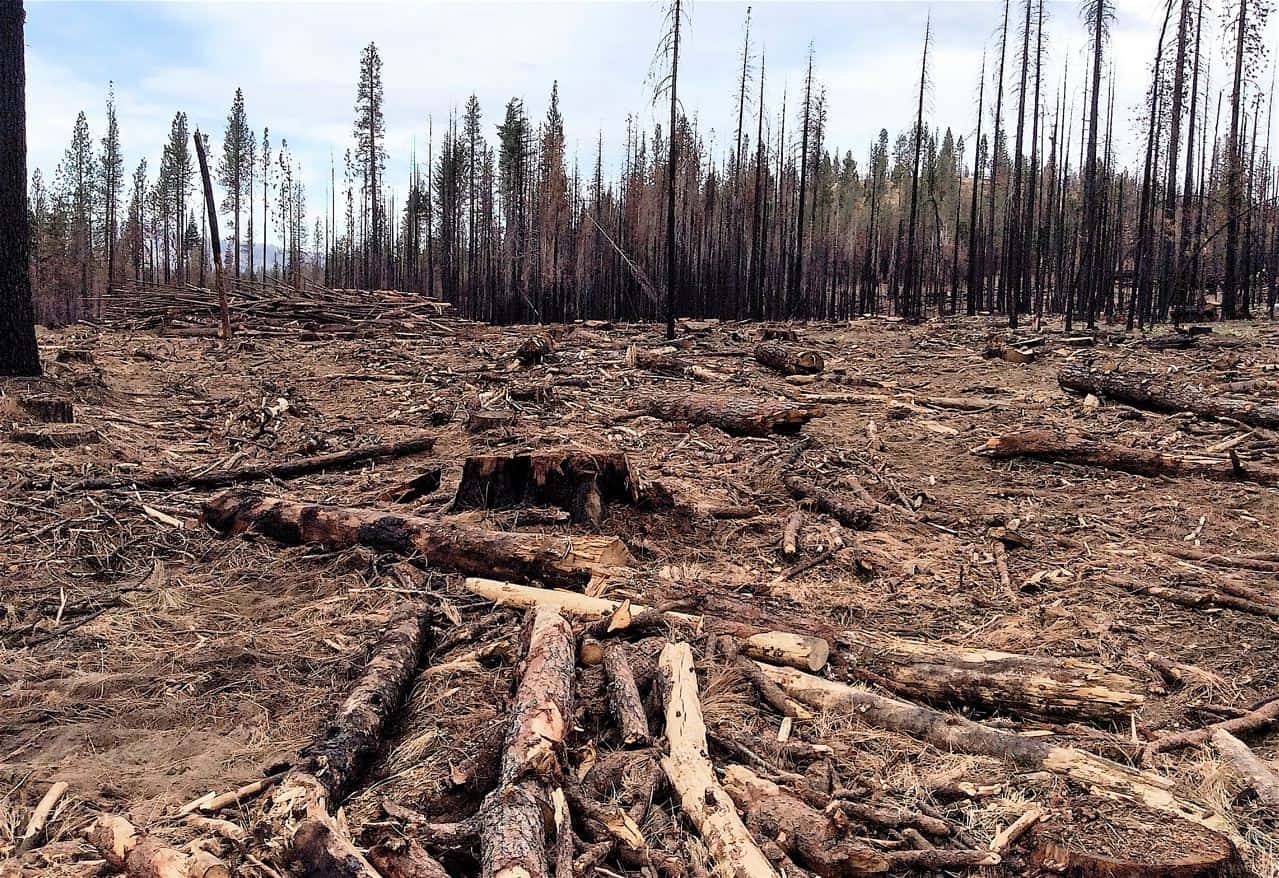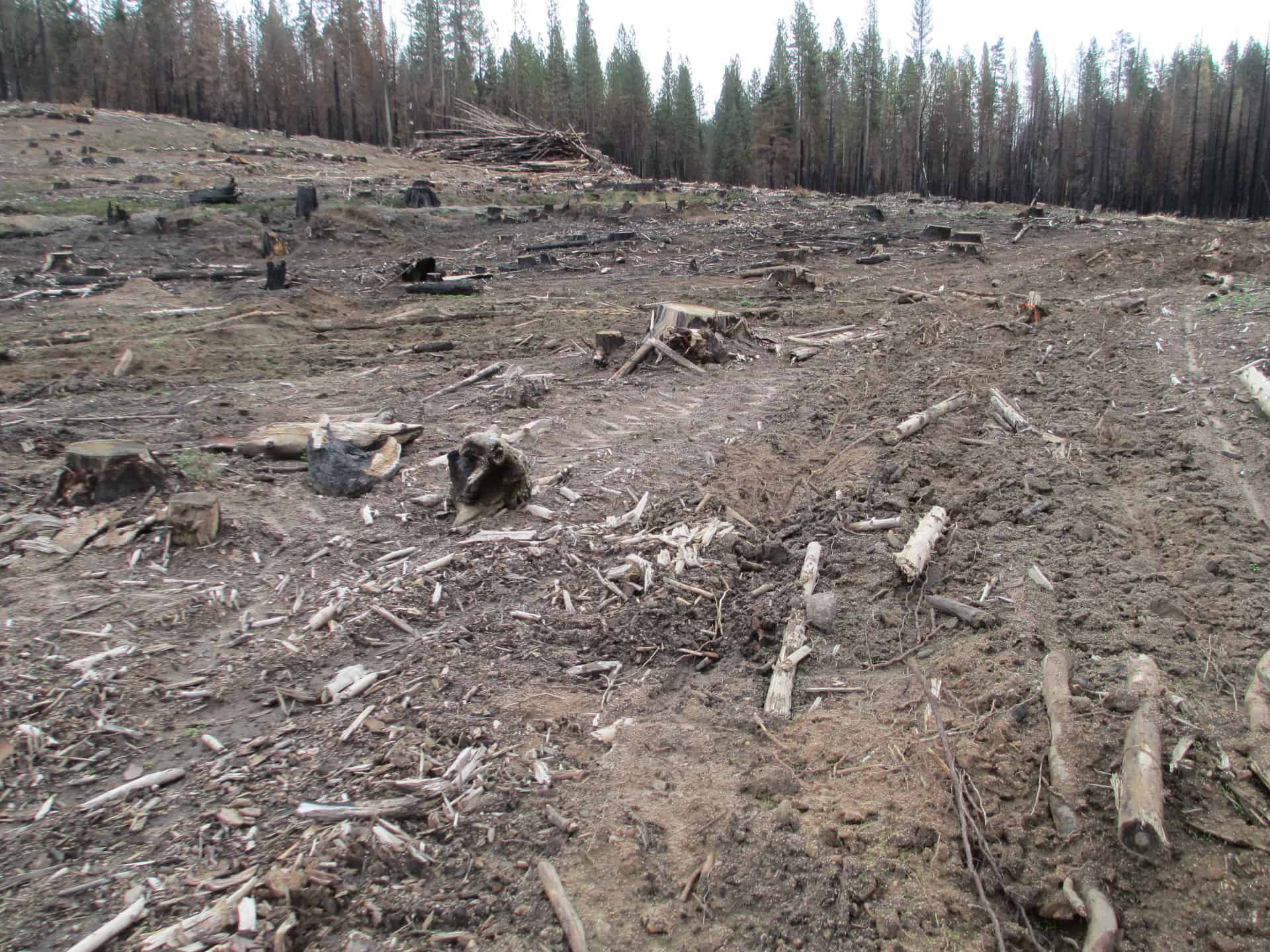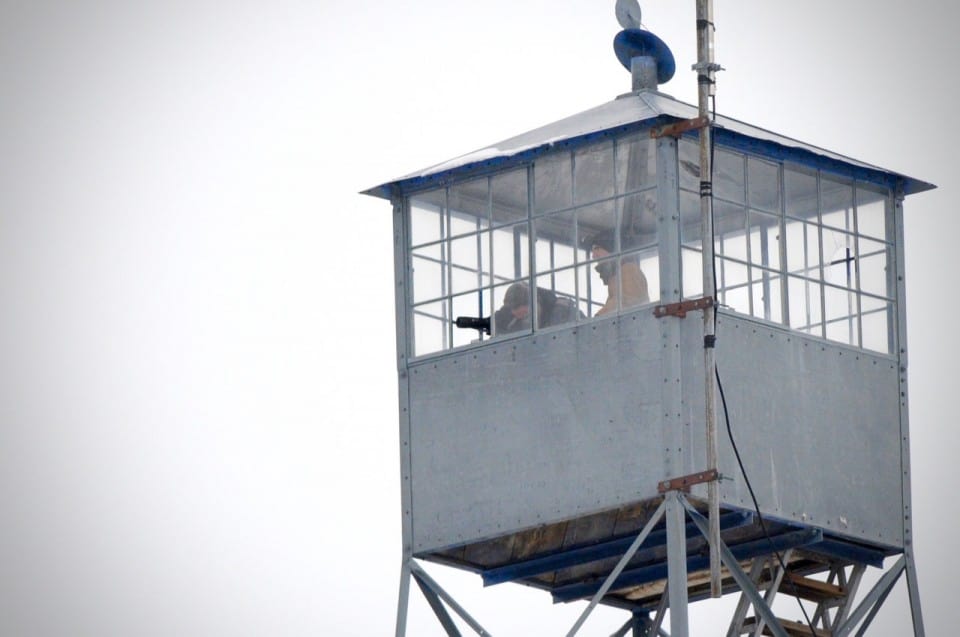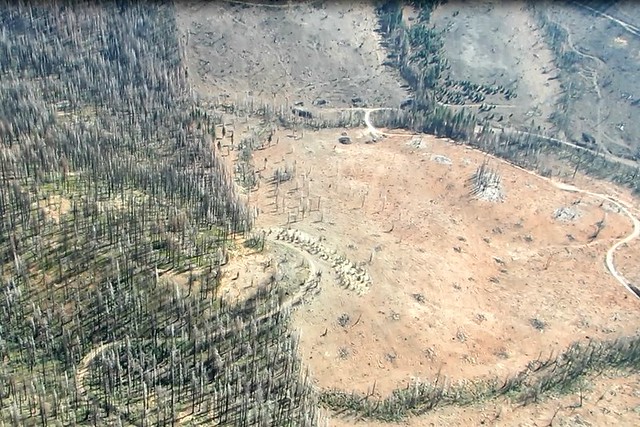
Post-fire clearcutting on the Stanislaus National Forest in the Rim fire area, eliminated the wildlife-rich snag forest habitat and left only stump fields. Photo by Maya Khosla.
[NOTE: The following article first appeared in the Earth Island Journal. – mk]
Clearcuts for Christmas?
Pro-logging “rider” bill in Congress would allow clearcutting in our national forests
By Dr. Chad Hanson
When Americans think about the presents they want for the Holidays, clearcuts on our national forests and other federal public lands is not what they have in mind. But that is exactly what radical, anti-environmental members of Congress are proposing to do right now — make a generous gift to the logging industry.
Republicans in the Senate are using the upcoming December 11 government-funding deadline and fear and misinformation about wildland fire in our forests, to pressure some Democrats and the Obama Administration to go along with a logging bill that would be attached as a “rider” to the Omnibus appropriations act in the coming days. The logging rider would suspend environmental laws to allow commercial logging projects to go forward on our national forests and other federal forestlands through “categorical exclusions.” The rider would, among other things, effectively exempt logging from any environmental analysis or disclosure of adverse impacts on imperiled wildlife species, watersheds, or forest carbon storage. The provisions of the logging rider are similar or identical to many of those in HR 2647, which House Republicans passed earlier this year.
Troublingly, though the logging rider is being led primarily by Republicans, some Democrat Senators from states with an active timber industry presence too, appear to be willing to go along with the proposal. Worse, there are indications that President Obama may be willing to acquiesce to Republicans on the logging rider in exchange for an agreement over increased funding for ill-advised and ineffective backcountry fire suppression. Indeed, the recent fire-phobic and pro-logging rhetoric coming from a few western Democrats, such as Senator Ron Wyden from Oregon, is virtually indistinguishable from the media messages coming from logging industry spokespersons.
Built on deceptions, the logging rider promotes the planned expansion of timber sales on our public lands under the guise of “fuel reduction”, “restoration”, and fire management, Much of the increase in logging would be clearcutting of both old forest and ecologically vital post-fire habitat.
For example, one of the logging categories in the rider promotes clearcutting of mature and old forest ostensibly to create “early seral” conditions for wildlife. This sort of hyper-cynical spin is what now passes for cleverness in Washington, D.C. But the advocates of the logging rider are profoundly at odds with current science. As more than 260 scientists told Congress and the Administration in a recent letter, “complex early seral forest” is one of the most ecologically vital and wildlife-rich forest habitat types, and it is only created by patches of intense fire in forests and is destroyed by post-fire logging. Clearcutting removes and damages habitat, and there is not much wildlife activity in a giant stumpfield.
In fact, there is actually a deficit of post-fire forest habitat created by these beneficial fires, and many of the wildlife species that depend upon the unique “snag forest habitat” created by more intense fire patches have become rare and imperiled, and/or are declining, due to fire suppression, “fuel reduction” logging, and post-fire logging, as detailed in the recent book, The Ecological Importance of Mixed-Severity Fires: Nature’s Phoenix.
The fundamental premise upon which this “Clearcuts for Christmas” logging rider rests — that environmental protections supposedly lead to more intense fire and logging reduces fire intensity — is quite simply one of the most profound deceptions in the history of forest management.
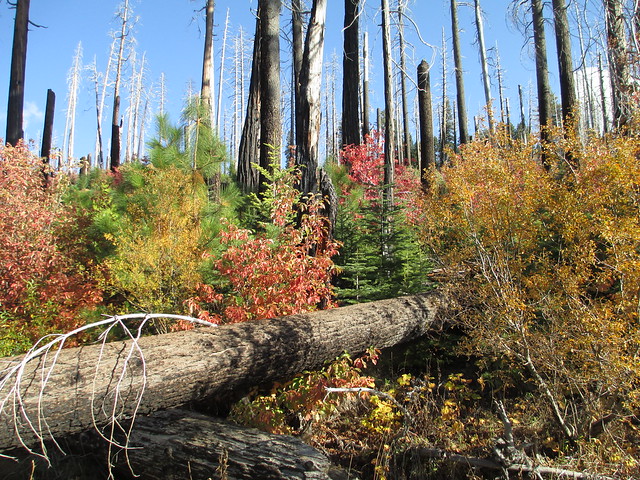
An ecologically-rich complex early seral forest, or “snag forest habitat”, created by high-intensity fire, with an abundance of snags (standing fire killed trees), native flowering shrubs, natural regeneration of conifer saplings, and downed logs used by small mammals and amphibians. Photo by Chad Hanson.
In one large fire after another in recent years, such as the California Rim fire of 2013 in the Sierra Nevada, the forests with the least environmental protections and the most significant logging history burned most intensely, while forests that were completely protected from logging, with no logging history, burned the least intensely. This is true even when key factors such as forest type and topography are taken into account. Nor does logging conducted under the banner of “thinning” meaningfully reduce fire intensity.
Research shows that it is previous fires, not thinning, that modify fire intensity and spread. For example, forests that have been thinned tend to burn more intensely when wildland fire occurs. Forests that have a combination of both thinning and prescribed fire tend to burn about the same as those with prescribed fire alone, and no thinning; in other words, thinning does not make forests burn less intensely but can sometimes increase fire intensity. Though the term sounds benign, in fact most “thinning” projects on national forests and other federal lands are intensive logging projects that often remove 50 to 80 percent of the trees in a given stand, including many mature and old trees. Such projects do not effectively modify fire intensity and unnecessarily cause significant damage to wildlife habitat for imperiled species like spotted owls and black-backed woodpeckers, while costing taxpayers hundreds of millions of dollars annually.
Moreover, increased logging and fire suppression in backcountry forests on our public lands will do nothing to help homeowners in rural forested areas where fire is a natural occurrence. In fact, by diverting scarce federal resources away from home protection, and focusing on logging and fire suppression in remote forests, the logging rider, and the fire suppression measure with which it is likely to be associated, would actually put rural homeowners at greater risk from fire. Further, the rider would increase risks to wildland firefighters by unnecessarily putting them in harm’s way in steep, difficult, remote terrain, as they try in vain to stop weather-driven, mixed-intensity fires that are creating important wildlife habitat and ecological benefits. As The Ecological Importance of Mixed-Severity Fires details, the only effective way to protect homes is to focus on making the homes themselves more fire-resistant, and to help homeowners create “defensible space” within 100 to 200 feet around homes by reducing combustible vegetation and removing lower limbs on mature trees.
It’s ironic that this logging rider is being proposed even as world leaders meet in Paris to address climate change. If the rider is passed, the increased logging on our public lands would substantially reduce carbon storage in our forests, significantly undermining climate solutions. There will be very little carbon storage in the thousands upon thousands of acres of stumpfields that would be created on our public lands if the logging rider becomes law.
The timber industry’s allies in Congress — in both political parties — want Americans to be as scared and confused about wildland fire as possible, because that’s the only political context in which something as regressive, unscientific, and wrong-headed as this logging rider has any chance to pass. This is particularly true in the cover-of-darkness type of legislating that occurs during appropriations season. There is no public dialogue, no open committee hearings, or informed debate. There are only closed-door meetings and back-room deals.
But the truth is that we shouldn’t be afraid of fire in our forests. Fire is not “destroying” our forests, as self-serving, pro-logging members of Congress would have you believe. Rather, fire is doing important and beneficial ecological work on our national Forests and other federal forestlands. And, if homeowners take basic, proven steps to protect their homes and the immediate vicinity, homes have a better than 90 percent chance of surviving a wildland fire. Homeowners need help to do this, but the logging rider, coupled with more backcountry fire suppression, would take us in exactly the wrong direction.
What you can do: Call the Capitol Switchboard at 202-224-3121, ask to be transferred to the offices of your Senators, and leave a comment with the environmental aide for each of them, urging Senators to stand firm against the “Clearcuts for Christmas” logging rider, and oppose any logging riders from being added to spending bills. Please also call the White House at 202-456-1111 and urge the President to oppose the logging rider. Finally, please write letters to the editor to your local newspapers to get the message out there about this issue.
Chad Hanson, the director of the John Muir Project (JMP) of Earth Island Institute, has a Ph.D. in ecology from the University of California at Davis, and focuses his research on forest and fire ecology in the Sierra Nevada. He can be reached at [email protected], or visit JMP’s website at www.johnmuirproject.org for more information, and for citations to specific studies pertaining to the points made in this article.
UPDATE: Here are some more John Muir Project photos from post-fire logging on the Stanislaus National Forest from within the Rim Fire area.
UPDATE #2: Wildfire-logging deal throttled by Senate ENR leaders (as well as grassroots forest protection groups, such as John Muir Project) [LINK]
